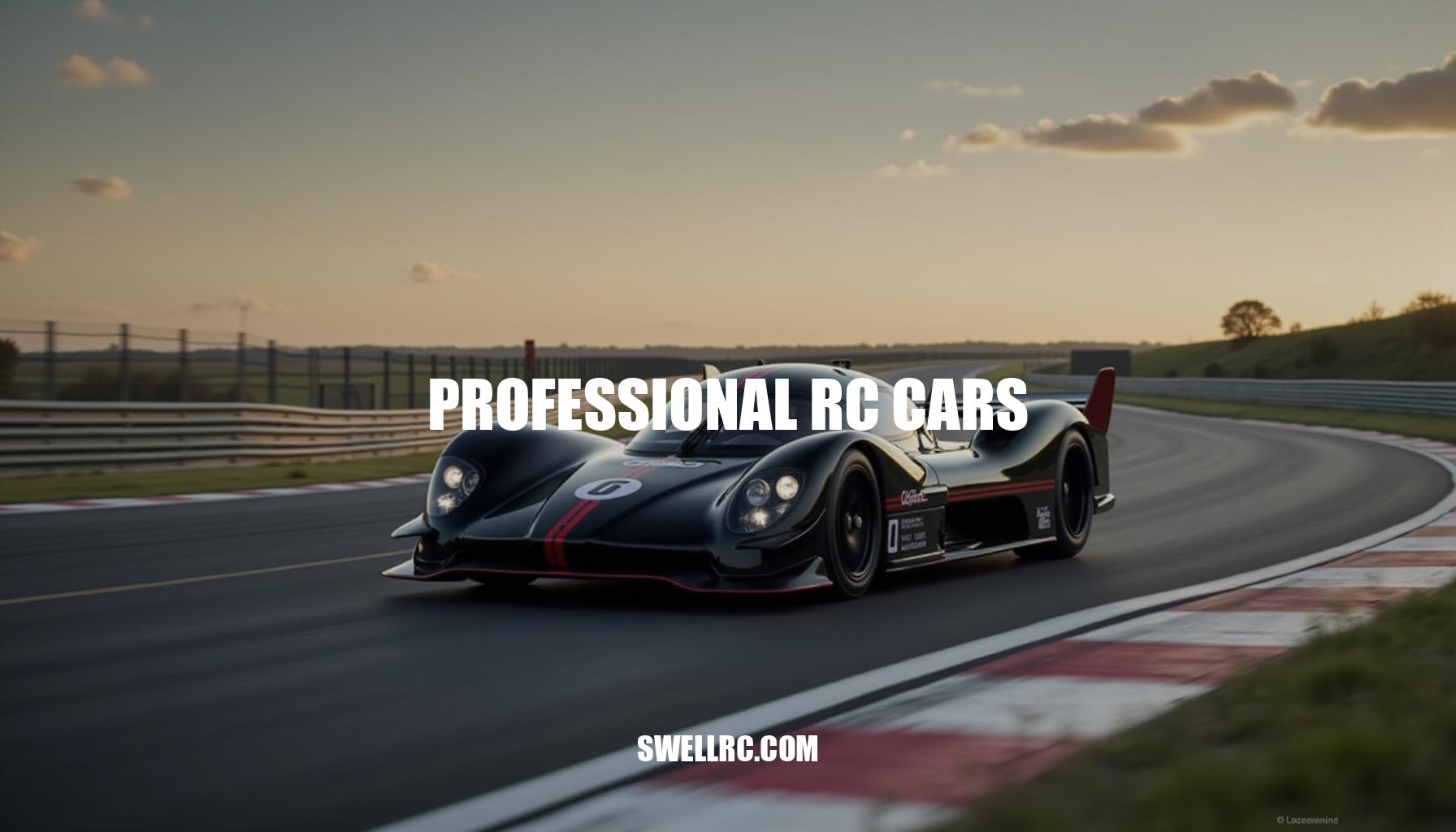The Thrill of Professional RC Cars
The moment my heart raced wasn’t just about speed—it was the instant I clocked my first 100+ mph pass on a freshly tuned professional RC car, feeling the race-tuned chassis rotate perfectly through a tight sweeper as if it had a mind of its own. This isn’t child’s play; modern remote control cars have evolved far beyond toys. Today’s high-performance RC vehicles are engineered for serious adults, competition, and precision driving.
In this guide, when I say professional RC cars, I mean machines equipped with brushless power systems, race-grade materials, precision radios, tunable suspension setups, and components designed not only to perform flawlessly but to be maintained and upgraded over time. We’ll dive deep into the exhilarating blend of speed and control, unpack the tech stack behind electric RC racers—including motors, ESCs, and gear ratios—explore different sizes and scales, navigate budget realities, and showcase pro-ready models that deliver world-class RC racing experiences. Join me as we unpack the world of professional RC cars with enthusiasm, technical clarity, and insights born from countless hours of hands-on testing.
What Makes a Professional RC Car?
When diving into the world of remote control cars, distinguishing between toy-grade and professional-grade RC vehicles is crucial for enthusiasts eager to experience serious performance and customization. From hands-on experience, the differences are striking across several components, much like comparing a family sedan to a finely tuned sports car.
| Component | Toy-Grade RC Cars | Professional-Grade RC Cars | Real-Car Analogy |
|---|---|---|---|
| Chassis Materials | Primarily plastic, which is lightweight but less durable | High-quality aluminum or carbon fiber, offering strength and rigidity | Plastic frame = economy hatchback; aluminum/carbon = lightweight sports coupe |
| Drivetrain | Basic gear mesh prone to wear, often no diffs or sealed diffs | Precision gear mesh with metal gears, functional differentials for better handling | Basic open diff vs. limited-slip or locking diff for better cornering |
| Power Systems | Brushed motors with limited efficiency and power | Brushless motors offering higher speed, efficiency, and durability | Brushed = old carbureted engine; brushless = modern fuel-injected engine |
| Electronics | Basic ESC without programming, noticeable radio latency, minimal features | Programmable ESCs with customizable settings, low-latency radio systems, gyro and ABS integration | Standard ECU vs. fully customizable, tunable car computer |
| Suspension Design | Simple spring shocks, little to no adjustability | Oil-filled shocks with adjustable geometry, spring rates, and damping | Basic shock absorbers vs. adjustable coilovers with adjustable camber, caster, and toe |
| Parts Support | Limited spare parts, mostly fixed assemblies, little hop-up potential | Extensive parts ecosystem, readily available hop-ups and upgrades, easy servicing | Non-serviceable parts vs. aftermarket performance upgrades and easy maintenance |
For those really interested in RC car tuning, think of camber, caster, and toe settings like the alignment tweaks in real cars that influence cornering and tire wear. Similarly, changing spring rates in oil-filled shocks lets you fine-tune ride stiffness, much like upgrading suspension springs on a race car. Gear ratios in brushless motors and ESCs allow optimization for speed vs.
torque—similar to selecting gearboxes for street driving or drag racing.
Speaking of brushless systems, they represent a major leap forward in performance and efficiency for professional RC cars. Brushed motors can feel sluggish and wear out quickly, while brushless motors combined with programmable ESCs provide precise power delivery and improved durability. If you’re considering an upgrade or a new purchase, be sure to check out our comprehensive best brushless RC car buyer’s guide to identify top models.
For fans of rugged, off-road RC cars, durability is paramount. The Rovan RF5 stands out as a prime example of a robust platform built to withstand harsh terrain, combining a metal chassis, oil-filled shocks, and strong drivetrain components—a perfect bridge between fun and professional specs.
Quick Pro-Grade Spec Checklist:
- Metal differentials (front, center, rear) for precision handling
- Oil-filled shocks with adjustable damping and springs
- Programmable ESC supporting advanced motor curves and settings
- Vibrant parts ecosystem with readily available upgrades and replacements
- High-precision, low-latency transmitter with fine-tuning options
Understanding these differences helps anyone—from hobbyists to serious racers—make informed choices when investing in professional RC cars that deliver superior performance, customization potential, and longevity.
Speed, Power, and Control: The Engineering of Excellence
When diving into the performance spectrum of high-performance RC vehicles, it’s fascinating to see how speed and control evolve from standard setups to professional-grade machines. Out of the box, many models achieve a respectable 40–60 mph, delivering thrilling acceleration and responsive handling perfect for newcomers and casual racers. However, once you explore the realm of fastest professional RC cars, the velocity jumps significantly, with high-end setups capable of hitting 70–100+ mph.
This leap isn’t just about raw power but a nuanced balance between several critical factors.
At the heart of these electric RC racers lies the game-changing role of brushless motors paired with LiPo batteries of varying voltages—typically 2S, 3S, or even 6S and beyond. Higher LiPo voltages amplify power output, pairing seamlessly with tailored gearing choices to optimize both acceleration and top-end speed. For example, increasing the pinion gear teeth count shifts acceleration for higher sustained velocity, while adjusting the spur gear can boost torque for quicker launches.
Moreover, RC car tuning is incomplete without considering ESC timing and boost settings, which regulate motor responsiveness and efficiency. Fine-tuning these parameters unlocks additional horsepower without sacrificing battery longevity. Tire compounds and body aerodynamics further refine this balance by providing grip and stability—critically important when pushing beyond 70 mph, where aerodynamic forces greatly influence vehicle confidence on long straights.
From personal testing, the marked improvement in aero stability at high speeds genuinely transformed the driving experience, making each run feel composed and controlled.
For enthusiasts seeking rally-bred finesse, the HPI WR8 Flux stands out as an excellent example, brilliantly marrying rugged durability with razor-sharp handling thanks to its sophisticated suspension and powertrain setup.
If you’re aiming to explore the best choices across these performance tiers, don’t miss our comprehensive fast RC cars for adults roundup, featuring platforms that suit both high-speed thrill seekers and precise handling aficionados. For a deeper dive into the pinnacle of RC performance, the super RC car overview showcases models that push the envelope in every engineering aspect.
| Platform Type | Typical Top Speed | Key Components | Maintenance Demand |
|---|---|---|---|
| Electric (Brushless/LiPo) | 40–100+ mph | Brushless motors, LiPo cells, ESC tuning, aerodynamics | Moderate (battery care, motor brushes less frequent) |
| Nitro RC Cars | 30–70 mph | Internal combustion engine, fuel tuning, exhaust | High (engine tuning, fuel system maintenance) |
| Gas RC Cars | 40–70 mph | Larger gas engines, fuel tanks, mechanical gearboxes | High (engine rebuilds, fuel cleaning) |
In summary, unlocking the full potential of your RC vehicle demands a holistic approach combining motor technology, power source, gearing ratios, tire chemistry, and aerodynamic advancements. Through careful tuning and component selection, the acceleration, top speed, and stability required to compete with the fastest professional RC cars become attainable, whether you’re blazing on the track or mastering off-road trails.
Scale and Size: Choosing the Right Fit for You
When diving into the world of off-road RC cars, understanding how scale and size influence handling, durability, terrain choice, transport/storage, and ownership cost is essential for every enthusiast. The scale directly affects the car’s behavior and practical aspects, so let’s break down popular scales:
- 1/10 Scale: Highly versatile, this scale is dominant in many electric RC racers and racing classes. Their compact size allows seamless indoor and outdoor use, boasting excellent control precision. They are easier to transport and store, making them beginner-friendly and budget-conscious.
- 1/8 Scale: Larger and heavier-duty, these vehicles reach higher speeds and handle bigger jumps. They demand rougher terrain, leaning more towards outdoor environments. They require more storage space and slightly higher upkeep costs but provide enhanced durability and thrilling performance.
Both electric and nitro options exist, each offering unique tuning and control dynamics.
- 1/5 Scale: These ultra-large machines are primarily outdoor-only platforms, offering a commanding presence and rugged capability. Their premium upkeep matches their complexity and size, often attracting experienced hobbyists who appreciate the big-bore, long-run-time rigs and mechanical simplicity. These attributes make them ideal candidates for gas powered RC truck kits, where the robust engines deliver distinct power and satisfying control feedback.
Each scale also influences your choice between electric and gas/nitro propulsion: electric RC racers in smaller scales grant quick responsiveness and low maintenance, while at larger scales, gas or nitro-powered rigs provide extended run times and thrilling torque impact. For adult enthusiasts seeking serious adrenaline, exploring large RC cars for adults offers a range of options tailored for big-scale excitement and versatility.
Personally, transitioning from 1/8 to 1/5 scale highlighted noticeable differences in control dynamics—braking distances extended, weight transfer became more pronounced, and reliance on electronic gyro assistance lessened, giving a raw, immersive driving experience that’s hard to match in smaller models.
Budget vs. Performance: Finding Real Value
When navigating the diverse price-to-performance spectrum of RC cars, understanding what you get at each investment level can clarify the age-old question: what is the difference between toy and professional RC cars? Generally, options under $300 serve as gateway brushless models that offer limited tuning but excellent entry points. Moving up to the $500–$1000 range, buyers encounter race-capable rollers and Ready-to-Run (RTR) models featuring authentic electronics and meaningful customization capabilities. For enthusiasts willing to invest $1000 and beyond, the market opens up to premium kits, professional-grade electronics, and plentiful spare parts—ideal for those craving top-tier performance or collector-grade status.
Here’s a snapshot of what you typically get by price range:
- Under $300: Affordable brushless motors, basic tuning, ideal for beginners exploring how to choose a professional RC car.
- $500–$1000: Enhanced electronics, competitive rollers/RTFs, fine-tuning options, and improved durability.
- $1000+: Pro-grade kits, advanced telemetry, superior suspension parts, and full spares ecosystems.
For shoppers seeking bargains that still rip, it’s possible to find hidden gems that punch well above their weight class.
Total cost of ownership is crucial here, often overlooked by newcomers; batteries and charger ecosystems can escalate costs, as do tires—which are consumable by nature. Frequent maintenance and occasional spares further add to the investment. This aligns closely with the realities of RC car maintenance and weighing value vs performance when making a purchase.
Interestingly, a friend once tuned a solid mid-priced rig to outperform a much pricier competitor by optimizing gearing and suspension.
This anecdote underscores that clarity of goals—not brand hype—truly dictates success on the track. Whether you’re eyeing the best professional RC cars for beginners or plotting your next build, keep this principle top of mind.
On the opposite spectrum are halo builds and collector-grade machines that fascinate with their engineering and exclusivity. For a deep dive, check out this comprehensive guide on the most expensive RC car, which highlights the pinnacle of craftsmanship and performance.
Beyond Racing: Tricks, Stunts, and Custom Builds
For enthusiasts looking to upgrade RC car performance and celebrate the creative side of the hobby, there are practical paths to transform your vehicle into a stunt-ready machine or a personalized racer. Quick-win modifications such as swapping tires or foams, adjusting gearing, and fine-tuning shock oil and springs can make an immediate impact on handling and responsiveness. Aesthetic personalization options, including new body shells, wings, and lighting kits, allow for a unique look that stands out on the track or pavement.
For those ready to dive deeper, performance overhauls like brushless motor conversions, installing higher-voltage ESCs, and upgrading to metal drivetrains can elevate power and durability dramatically. As a personal anecdote, after installing a new brushless system, the torque and throttle resolution transformed my standing backflips into a controlled party trick—turning simple fun into jaw-dropping stunts.
Maintaining safety and reliability is paramount with these upgrades. I recommend consistent temperature monitoring to avoid overheating, adhering to diff service intervals for smooth operation, applying threadlocker on all metal-to-metal connections to prevent loosening, and waterproofing vulnerable electronics to extend durability in varied conditions.
When it comes to playful builds and stunt platforms, exploring curated resources can help guide your choices—especially the best RC stunt car guide, which breaks down ideal models and modifications for flips, spins, and wheelies.
Additionally, RC drift cars have their own tuning essentials. Using hard compound slick tires combined with gyro assist offers better drift control, while a low ride height enhances stability through slides. These considerations are crucial components in the world of RC car tuning and maintenance.
- Quick-win mods: tires/foams, gearing changes, shock oil/springs
- Aesthetic personalization: body shells, wings, lighting
- Performance overhauls: brushless conversions, higher-voltage ESCs, metal drivetrains
- Safety & reliability: temperature monitoring, diff service intervals, threadlocker on metal parts, waterproofing
- Stunt-ready setups: referencing the best RC stunt car guide for optimal builds
- RC drift cars basics: hard compound slicks, gyro assist, low ride height
Conclusion — The Real Joy of Professional RC Cars
What keeps me truly hooked on professional RC cars is that intoxicating blend of speed, control, craftsmanship, and community. Unlike ordinary toys, high-performance RC vehicles demand skillful RC car tuning and thoughtful setup, transforming each run into a thrilling test of precision and passion.
Let’s recap the big takeaways:
- Professional RC cars offer a vastly different experience compared to standard toys, emphasizing superior build quality and performance.
- The thrill of true performance comes from mastering every nuance—speed, handling, and endurance—that recreational models can’t match.
- Choosing the right scale impacts everything from portability to track adaptability and personal goals.
- It’s essential to balance your budget with your aspirations, ensuring your investment supports continuous growth and enjoyment.
I encourage you to keep experimenting with your setup and modifications, join local tracks and community groups, and dive into the linked in-depth guides sprinkled throughout this article to fuel your next steps on this exciting journey.
Remember, lifelong learning is at the heart of RC racing. There’s always another tenth of a second to find, another line to perfect, and another build to chase.
Embrace the challenges, savor the victories, and enjoy the camaraderie—the world of professional RC cars is waiting for you to explore it fully.
Frequently Asked Questions
- What makes an RC car professional-grade?
Professional-grade RC cars use brushless power systems, programmable ESCs, low-latency 2.4 GHz radios, oil-filled shocks with tunable geometry, metal drivetrain components, and have robust parts support for racing and repairs. They’re designed to be serviced, tuned, and upgraded—just like full-size race cars. - How fast can professional RC cars go?
Out of the box, many pro models hit 40–60 mph. With high-voltage LiPos, optimized gearing, and aero, well-sorted setups can reach 70–100+ mph, and specialized speed-run builds can exceed 120 mph on prepared surfaces. - Are brushless RC cars better than brushed ones?
For performance, yes. Brushless motors are more efficient, deliver higher power-to-weight, run cooler, and require less maintenance. Brushed can be cheaper and simpler, but brushless dominates competitive and high-speed applications. - What are the top brands that make professional RC cars?
Standout brands include Traxxas, Arrma, Team Associated, Losi, Mugen Seiki, Xray, Serpent, Kyosho, and HPI Racing. Your best choice depends on class (on-road, off-road, drift) and local parts support. - Can adults race professional RC cars competitively?
Absolutely. Adult participation drives most RC racing. Local clubs run weekly programs across classes (1/10, 1/8, on-road, off-road, drift), and regional/national events welcome newcomers with spec and open categories.



